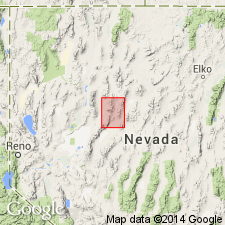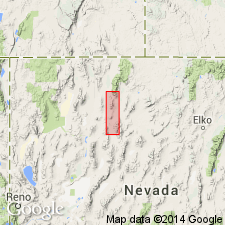
- Usage in publication:
-
- Dun Glen formation*
- Modifications:
-
- Original reference
- Dominant lithology:
-
- Dolomite
- AAPG geologic province:
-
- Great Basin province
Summary:
See also H.G. Ferguson and others, 1951, Geol. Winnemucca quadrangle, NV, USGS Geol. Quad Map GQ-11, 1 sheet, scale 1:125,000.
Dun Glen formation. Dark-gray to black massive dolomite, in part cross-bedded, standing in bold relief; interbedded with limestone and shale in lower 100 feet. In Stillwater Range, principally nodular limestone with some quartzite near base. Thickness generally 500 to 600 feet but reaches 1,150 feet in northwestern part of Sonoma Range. Underlies Winnemucca formation with local unconformity; overlies Grass Valley formation. Age is Late Triassic (Karnian), based on fossils in underlying and overlying formations.
Type locality (see Ferguson and others, 1951): Dun Glen Peak, East Range [T. 34 N., R. 36 E.], Winnemucca quadrangle (scale 1:100,000), Pershing Co., north-central NV. [Named for Dun Glen Peak.]
Source: Publication; US geologic names lexicon (USGS Bull. 1200, p. 1179); GNU records (USGS DDS-6; Menlo GNULEX).

- Usage in publication:
-
- Dun Glen Formation*
- Modifications:
-
- Revised
- AAPG geologic province:
-
- Great Basin province
Summary:
Included as second oldest formation in Auld Lange Syne Group (new). Type locality of Muller and others (1951) redesignated as type area: Sec.26, T34N R36E, Rose Creek 15' quad, Pershing Co, NV. Unit occurs in north Sonoma Range, north East Range, south Humboldt Range, north Stillwater Range and south Tobin Range. In Santa Rosa Range, Dun Glen Formation is seemingly reduced to isolated lenses of carbonate rock mapped as Winnemucca Formation. Age remains Late Triassic (Norian).
Source: GNU records (USGS DDS-6; Menlo GNULEX).
For more information, please contact Nancy Stamm, Geologic Names Committee Secretary.
Asterisk (*) indicates published by U.S. Geological Survey authors.
"No current usage" (†) implies that a name has been abandoned or has fallen into disuse. Former usage and, if known, replacement name given in parentheses ( ).
Slash (/) indicates name conflicts with nomenclatural guidelines (CSN, 1933; ACSN, 1961, 1970; NACSN, 1983, 2005, 2021). May be explained within brackets ([ ]).

